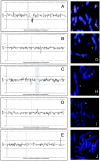Array-based comparative genomic hybridization for the genomewide detection of submicroscopic chromosomal abnormalities
- PMID: 14628292
- PMCID: PMC1180392
- DOI: 10.1086/379977
Array-based comparative genomic hybridization for the genomewide detection of submicroscopic chromosomal abnormalities
Abstract
Microdeletions and microduplications, not visible by routine chromosome analysis, are a major cause of human malformation and mental retardation. Novel high-resolution, whole-genome technologies can improve the diagnostic detection rate of these small chromosomal abnormalities. Array-based comparative genomic hybridization allows such a high-resolution screening by hybridizing differentially labeled test and reference DNAs to arrays consisting of thousands of genomic clones. In this study, we tested the diagnostic capacity of this technology using approximately 3,500 flourescent in situ hybridization-verified clones selected to cover the genome with an average of 1 clone per megabase (Mb). The sensitivity and specificity of the technology were tested in normal-versus-normal control experiments and through the screening of patients with known microdeletion syndromes. Subsequently, a series of 20 cytogenetically normal patients with mental retardation and dysmorphisms suggestive of a chromosomal abnormality were analyzed. In this series, three microdeletions and two microduplications were identified and validated. Two of these genomic changes were identified also in one of the parents, indicating that these are large-scale genomic polymorphisms. Deletions and duplications as small as 1 Mb could be reliably detected by our approach. The percentage of false-positive results was reduced to a minimum by use of a dye-swap-replicate analysis, all but eliminating the need for laborious validation experiments and facilitating implementation in a routine diagnostic setting. This high-resolution assay will facilitate the identification of novel genes involved in human mental retardation and/or malformation syndromes and will provide insight into the flexibility and plasticity of the human genome.
Figures


References
Electronic-Database Information
-
- BACPAC Resources Center, http://www.chori.org/bacpac/
-
- BACPAC Resources Center's Human BAC Minimal Tiling Set Web site, http://bacpac.chori.org/pHumanMinSet.htm
-
- Online Mendelian Inheritance in Man (OMIM), http://www.ncbi.nlm.nih.gov/Omim/ (for PWS, SMS, and TRPS)
References
-
- Albertson DG, Pinkel D (2003) Genomic microarrays in human genetic disease and cancer. Hum Mol Genet: 12:R145–152 - PubMed
-
- Anderson G, Schroer RJ, Stevenson RE (1996) Mental retardation in South Carolina. II. Causation. In: Saul RA, Phelan MC (eds) Proceedings of the Greenwood Genetic Center. Greenwood Genetic Center, Greenwood, SC, pp 32–44
Publication types
MeSH terms
LinkOut - more resources
Full Text Sources
Other Literature Sources
Miscellaneous

